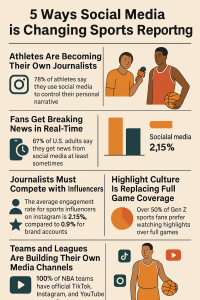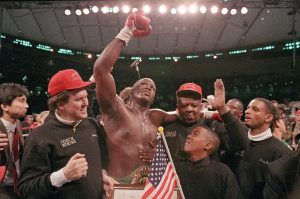
Sports reporting isn’t just coming from TV anchors or newspaper writers anymore. Social media has transformed how fans get their sports news—fast, unfiltered, and often straight from the source. Athletes, teams, and influencers are now just as powerful as traditional journalists, reshaping communication in the sports world.
1. Athletes Are Becoming Their Own Journalists
Instead of waiting for interviews or press conferences, many athletes now break their own news.
Example: Kevin Durant announced his decision to join the Golden State Warriors via The Players’ Tribune.
Data: 78% of athletes say they use social media to control their personal narrative 1.
2. Fans Get Breaking News in Real-Time
Twitter and Instagram often break news faster than ESPN. Journalists now live-tweet games and post updates before even writing full articles.
Data: 62% of U.S. adults say they get news from social media at least “sometimes” 2.
3. Journalists Must Compete with Influencers
Sports influencers and fan pages are creating content that gets more traction than official outlets. Communication pros must now focus on engagement as much as accuracy.
Data: The average engagement rate for sports influencers on Instagram is 2.15%, compared to 0.9% for brand accounts 3.
4. Highlight Culture Is Replacing Full Game Coverage
Instead of watching full games, fans are often satisfied with short highlight clips posted online. This has changed how content is produced and shared.
Data: Over 50% of Gen Z sports fans prefer watching highlights over full games 4.
5. Teams and Leagues Are Building Their Own Media Channels
Pro teams now hire full media crews to control their messaging. They post exclusive interviews, behind-the-scenes footage, and daily content on their own platforms.
Data: 100% of NBA teams have official TikTok, Instagram, and YouTube channels as part of their media strategy 5.
Social media is rewriting the rules of sports communication. From breaking news to highlight reels, fans now expect instant, personal, and engaging content. This shift means sports communicators must adapt quickly, blending journalism, branding, and digital media skills to keep up.
- Gaines, C., & Fink, J. S. (2018). “Athlete Self-Presentation and Fan Engagement on Social Media.” Journal of Sport Management, 32(4), 321–331 ↵
- Pew Research Center. (2021). “News Consumption Across Social Media in 2021. ↵
- Influencer Marketing Hub. (2023). “Instagram Engagement Benchmarks by Industry. ↵
- Morning Consult. (2022). “Gen Z and the Future of Sports Fandom. ↵
- NBA Communications. (2023). “NBA Social Media Trends Report. ↵


